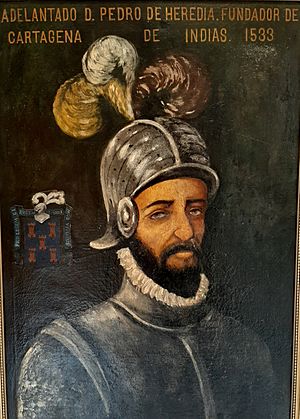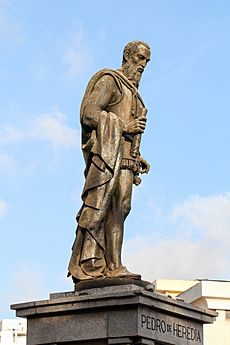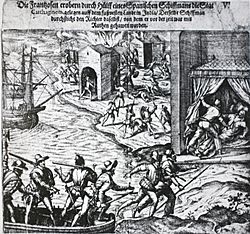Pedro de Heredia facts for kids
Quick facts for kids
Pedro de Heredia y Fernández
|
|
|---|---|
 |
|
| Born | 1505, circa |
| Died | 27 January 1554 |
| Nationality | Spanish |
| Occupation | Explorer, Conqueror |
Pedro de Heredia (born around 1505 in Madrid, Spain – died January 27, 1554, in Zahara de los Atunes, Cádiz, Spain) was a Spanish explorer and a conquistador. He is famous for founding the city of Cartagena de Indias in what is now Colombia. He also explored the northern coast and inland areas of this region.
Contents
Early Life and Adventures
Pedro de Heredia came from a wealthy and important family in Spain. Even when he was young, he was known for being brave and getting into exciting situations. One time in Madrid, he was in a big fight where he was badly hurt, leaving his nose disfigured. After this event, he had to leave Spain quickly to avoid trouble, so he sailed to the New World.
First Trip to the New World
Heredia traveled to the Caribbean with his brother, Alonso de Heredia. They settled in Santo Domingo, the main city on the island of Hispaniola. There, they took over a sugar mill and a large farm.
Later, when the governor of Santa Marta passed away, Pedro de Heredia was chosen to be a leader there. In 1528, he arrived in Santa Marta with 200 men. He gained a lot of experience dealing with the native people. He traded things like mirrors and bells for valuable items. After a while, he returned to Santo Domingo and then sailed back to Spain.
Planning a New Expedition

Once back in Madrid, Heredia worked to get permission from the Spanish Crown for a new adventure. He wanted to conquer and govern the area around the Bay of Cartagena and a region called New Andalucía. This area covered a huge part of what is now Colombia and even part of Ecuador.
In August 1532, Queen Joanna of Castile signed an agreement, giving him the title of adelantado (a special title for a conqueror). Heredia then went to Seville to prepare. He gathered three ships: a large galleon, a caravel, and a smaller patache. In November 1532, he set sail from Cadiz with 150 men and 22 horses.
Heredia first stopped in Puerto Rico. There, he met some survivors from another expedition. He added some of their experienced officers to his own group. Then, he sailed to Santo Domingo, where he visited his farms. He also brought along some native people and enslaved people, a few Spanish women, and an important interpreter named India Catalina. She was a native woman who spoke both Spanish and local native languages, which was very helpful for communication.
Founding Cartagena de Indias
After spending Christmas in Santo Domingo, Heredia sailed across the Caribbean Sea to the South American mainland. He explored the coast, passing by the mouth of the Magdalena River. On January 14, 1533, he reached a large village called Calamari, located on the shore of Cartagena Bay.
After some intense fighting with the native people of the Turbaco area, Heredia founded a new city. He named it Cartagena de Indias because its bay reminded him of Cartagena, Spain. To tell them apart, he sometimes called it "Cartagena de Poniente." The exact date of the city's founding is debated, but the Colombian Academy of History officially recognizes June 1, 1533.
Exploring Inland and Facing Challenges
Pedro de Heredia made agreements with the leaders of nearby islands. With the help of India Catalina, he explored and took control of the area around Cartagena, including Turbaco and the Magdalena River. He found many valuable gold objects in ancient burial sites in the Sinú River area and founded the town of Santiago de Tolú. From these trips, he brought back a huge amount of gold, including a solid gold porcupine weighing 132 pounds! His soldiers also received a lot of gold, much more than soldiers in other conquests.
Heredia planned another trip towards the Pacific Ocean in 1534. He reached the Sinú River again, where he continued to find gold. He and his troops then traveled into the Antioquia Department before returning to Cartagena.
Later, Pedro de Heredia and his brother Alonso faced investigations about how they managed their positions and treated the native people. In 1536, a judge found Heredia responsible for some issues and he was temporarily removed from his position. Heredia went to Spain to defend himself and was found innocent.
He returned to Cartagena with some family members, including his two sons, Antonio and Juan. Soon after, Heredia went on a search for the legendary treasure of Dabeiba, which was part of the myth of El Dorado. After a long trip without finding the treasure, he returned.
In 1544, the city of Cartagena was attacked by a French nobleman named Jean-François Roberval. Cartagena was not yet strongly protected, so it was an easy target. Heredia and his family had to hide. The city had to pay a large amount of gold to make the French leave.
After this attack, Heredia faced another investigation in 1548 for abusing his power. He was found responsible for the charges and removed from his administrative role.
Death
In 1552, Pedro de Heredia faced many new accusations, including misusing royal money and being unfair to the native population. After being found responsible and removed from his position, Heredia decided to return to Spain to appeal the decision.
On January 27, 1554 (some sources say 1555), his ship, La Capitana, sank off the coast of Zahara de los Atunes in Spain. He tried to swim to shore, but his body was never found.
See also
 In Spanish: Pedro de Heredia para niños
In Spanish: Pedro de Heredia para niños



